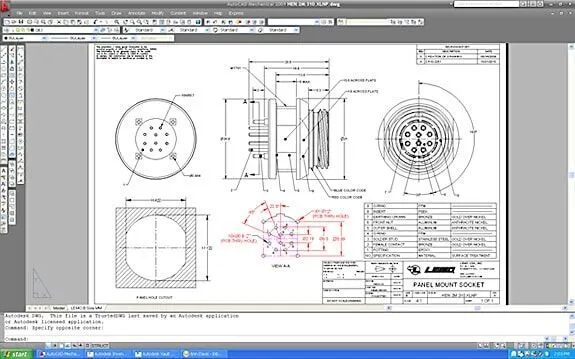Wide Format Scanning – Secrets for Successful Scans

Wide Format Scanning – Secrets for Successful Scans
Most large format scanner manufacturers claim ease of use and high-quality scans, so why do we see so many poor quality images when customers send us scanned images to convert to CAD? The biggest reason for this is, quite simply, scanner operator ignorance. Yes, today’s scanners are easy to use, and yes, they do provide great images, but if you don’t know the tricks of the trade that let you take advantage of the scanner’s full capabilities, your images are not going to live up to the hype!

Today’s automobiles are also remarkably easy to drive — many virtually park themselves, let you know if you’re following too closely to another vehicle and help you brake on slippery pavement, but you’re not likely to put an inexperienced driver behind the wheel and expect him to act as your chauffeur. Yet, that’s exactly the attitude many businesses have about scanning their documents…
They buy a new large format scanner, with all the bells and whistles, then put an inexperienced technician “behind the wheel” and wonder why the scanned image outcome is so poor, or worse yet, don’t even realize that the quality is poor due to their own ignorance or indifference.
Training, Technique and Trade Secrets
Just like with driving an automobile, “driving” a large format scanner does require some training, an understanding of technique, and knowledge of the special little tricks of the trade that you can learn only through experience. Let’s look at these issues:
What are you trying to achieve?

Management must first decide what they need the scanner for (1) archiving; (2) copying; (3) raster to vector conversion; (4) some combination of all three. Once management has their goals firmly in mind, they can purchase a scanner that will meet the goal(s). Then, rather than turning this piece of complex, albeit easy-to-use, the piece of equipment over to an inexperienced operator, they can ensure that the operator has sufficient training to understand the image quality requirements needed to meet management’s goal(s). For instance, the settings required for archiving may be different from the settings required for copying. Images destined for raster to vector conversion may require yet a completely different setting from that for either copying or be archiving.
For example, a quick copy for viewing can usually be scanned quickly at relatively low resolution, but if you’re scanning for raster to vector conversion then you need high accuracy, high resolution – the best the scanner can provide. This means a slower scan speed. While low-resolution scans (200 dpi) might sound like a good idea for archiving, because it keeps the file size small, and increases the scanning speed, you better hope you never need to convert them to vector drawings to be used in a CAD system. A resolution of 200 dpi is just too low to get the detail needed out of technical drawings in order to do an accurate raster to vector conversion. So, the time you saved with the low res scan is lost and additional time is required for re-scanning or re-drawing. When scanning for archive, scan at a resolution that will allow you to have the most flexibility with the image file going forward.
Should you hire an expert?
So, maybe rather than buying a large format scanner and training you’re own person, a better way to go is to hire a professional scanning service bureau to do your scanning for you. They’re experts, right?

Unfortunately, even the so-called scanning experts sometimes take short-cuts. We’ve seen many scans that were made by so-called professional scanning bureaus that aren’t good quality. Remember, a high accuracy, the high-resolution scan takes time. A slower scanning means lower profit…so those scanning bureaus who are out to make money above all else may cut corners. Your images likely will not be great, and may end up not even being “good enough.” So, be careful who you hire.
One way to ensure high-quality scans is to hire a service bureau that not only provides the scanning service but who also excels at raster to vector conversion. Even if you’re not planning to do the r2v conversion right away, or even if you think you’ll never need it, hiring a firm that knows what’s required is likely to provide you with better images from the start.
Scanning service bureaus who offer security clearance scanning services, and who are certified to perform scanning and conversion for the U.S. Department of Defense, are generally very well qualified to provide high-quality scans at affordable prices.
Conclusion
So, whether you’re going to buy a scanner and train someone to scan the kinds of images you require, or whether you’re going to outsource your scanning job, just make sure you have clear goals in mind and that you get the best-scanned images you can.
Recent Posts


CAD Outsourcing Doesn’t Have to Be Done In India
CAD Outsourcing Doesn’t Have to Be Done in India Do a Google search for “CAD Outsourcing” and what you’ll find is lots of firms located in India, which is fine if you’re prepared to go off-shore for CAD services. But what if your U.S. based company prefers to stay a...

AutoCAD Fiber Optic Designs & Drawings
Before proceeding forward in explaining the affinity between AutoCAD and Fiber Optic, it would be prudent to rationalize the utility of optical cables. When communicating between systems, either via the internet or via an internal network system, a medium needs to be...

CAD Outsourcing: How to Get the Most Out of Engineering
In today’s competitive market, companies need as much help as possible. If you want to take a larger market share, you can start by outsourcing some of your work. This is a quick way to expand your engineering power without onboarding and training a new staff. This...
